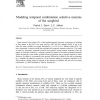Free Online Productivity Tools
i2Speak
i2Symbol
i2OCR
iTex2Img
iWeb2Print
iWeb2Shot
i2Type
iPdf2Split
iPdf2Merge
i2Bopomofo
i2Arabic
i2Style
i2Image
i2PDF
iLatex2Rtf
Sci2ools
IJON
2002
2002
Modeling temporal combination selective neurons of the songbird
Some neurons in the nucleus HVc of the songbird respond vigorously to sequences of syllables as they appear in the bird's own song (such as AB), but they respond weakly or not at all when the same syllables are played individually (A or B) or in a di erent order (BA). We have constructed a network model that replicates this temporal sequence selectivity. The model is based on recurrently connected networks that produce strong resonant responses when the pattern of excitation evoked by a stimulus matches the pattern of excitation generated internally within the network. In the model, syllable B does not generate such a resonant response by itself. However, if syllable A is presented to the network followed by syllable B, the activity generated by A modi
| Added | 22 Dec 2010 |
| Updated | 22 Dec 2010 |
| Type | Journal |
| Year | 2002 |
| Where | IJON |
| Authors | Patrick J. Drew, L. F. Abbott |
Comments (0)

